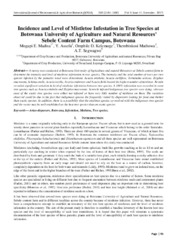Incidence and level of mistletoe Infestation in tree species at Botswana University of Agriculture and Natural Resources’ Sebele Content Farm Campus, Botswana

View/
Date
2017-11-11Author
Madisa, Mogapi E.
Assefa, Y.
Kelemoge, Omphile D.
Mathowa, Thembinkosi
Segwagwe, A.T.
Metadata
Show full item recordAbstract
A survey was conducted at Botswana University of Agriculture and natural Resources at Sebele content farm to determine the intensity and level of mistletoe infestation in tree species. The intensity and the total number of trees per tree species infected by the parasitic weed were determined. Acacia eriobola, Acacia mellifera, Terminalia sericea, Ziziphus mucronata, Schinus molle, Acacia tortilis, Acacia erubesens and Acacia flekii hosted the highest number of mistletoe. Results revealed significant variation in level of mistletoe infestation between tree species. A 100% infestation was recorded in some tree species such as Acacia eriobola and Ziziphus mucronata. Severely infested indigenous tree species were dying, whereas most of the exotic tree species were either not infested or have very little number of mistletoe on them. The variation observed could be due to the fact that indigenous species the frequently visited by dispensers looking for food and shelter than exotic species. In addition, there is a possibility that the mistletoe species co-evolved with the indigenous tree species and the vector may be well established on the host tree species than on exotic species.
URI
https://s3.amazonaws.com/academia.edu.documents/55244520/IJOEAR-NOV-2017-a9.pdf?response-content-disposition=inline%3B%20filename%3DIncidence_and_Level_of_Mistletoe_Infesta.pdf&X-Amz-Algorithm=AWS4-HMAC-SHA256&X-Amz-Credential=AKIAIWOWYYGZ2Y53UL3A%2F20200304%2Fus-east-1%2Fs3%2Faws4_request&X-Amz-Date=20200304T101528Z&X-Amz-Expires=3600&X-Amz-SignedHeaders=host&X-Amz-Signature=a10f394eefdd703a6dfd26d5332ea3088b922acc3c3688f2eabcd41c9040fe98http://moodle.buan.ac.bw:80/handle/123456789/238
Collections
- Reseach articles [146]
